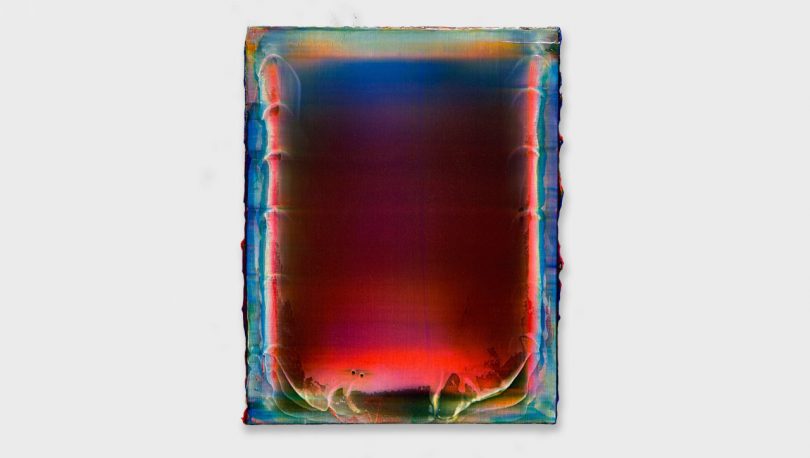Ryan Crotty’s latest paintings are on view at the High Noon Gallery in New York through August 28th. Despite what your eyes are telling you right now, this canvas is not transparent, and the surface is not emitting light. Crotty has just found a new way to paint.
Crotty’s primary tool is a customized piece of plexiglass that he uses like a squeegee to scrape paint across the surface of a canvas. Where the squeegee presses against the unseen wood support structure behind the canvas, the paint is almost entirely removed while the center of the canvas flexes under the pressure to accept greater degrees of paint. This process is repeated several times with multiple colors and layers to create a coating thick enough to produce a glass-like surface with other color transitions.
You don’t ever feel like you’re looking AT a Ryan Crotty painting… you feel like you’re looking THROUGH it. He produces an “x-ray” effect that reveals the unseen skeleton of the structure behind the canvas, while ALSO producing a beautiful painting on its surface.
Ryan prefers to purchase the store-bought pre-stretched canvases where the low-quality frames are more likely to interfere (art students will know what I’m talking about). The canvas on those frames however, isn’t good enough, so he replaces the cheap white canvas with a thicker high-quality linen, and often moves or adds central support bars. In “Grave this on Your Memory” (above), the center support bar was lowered before he started painting.
Once the frame is modified and canvas replaced, a base layer of white modeling paste is often applied – it’s a thicker paint that creates ripples and imperfections in the initial surface.
The most surprising secret of his process is revealed when examining the sides of the paintings. Small gobs of paint collect on the edges of the canvas (below) to reveal a historical record of the exact order of colors applied to the surface. Examine them all and you’ll find only 3 colors: red, yellow, and blue. There is no green, purple, or orange paint in any of these. The ILLUSION of those colors is produced by the translucent laying of the 3 primary colors, carefully monitored and controlled in thickness and density.
Though he sticks with “primary colors”, it should be noted that the particular blue or yellow or red can vary from work to work, and Crotty is constantly changing and experimenting with the concentration, transparency, and addition of other solutions to change the effects.
Ryan Crotty is an experimentation addict. Not only does he keep detailed notes on the EXACT mixtures, order, and process of every single painting, but he’s constantly pushing into new territory. In “LT-1.8” (pictured above), he used a piece of wavy plastic (the type used for roofing on greenhouses) placed behind the canvas and moved for every layer of color. And in “Two Sides, One Story” (below), the left and right half of the painting were created separately to challenge himself to produce identical results on each half. Errors in his ability to replicate the exact pressure on each half of the painting result in the slight differences.
The smallest works in the exhibition (below) are the most unique. From a distance they appear to be dirtier than the rest, but on closer inspection feature an incredibly complex network of sharp black lines. In these, Ryan applied a thin layer of black paint as the final layer, followed by a thin sheet of plastic. While the paint was wet, he used the custom squeegee to smash the plastic into the paint before slowly pealing it off to reveal the pattern. The technique was inspired by a studio mistake that involved a paint-soaked spatula that was accidentally placed directly on his work table.
The fact that this exhibition exists RIGHT NOW will come as an even greater surprise to those familiar with the New York art world. July and August are recognized as the “gallery off season” – a two month art drought where every gallery exhibits “group exhibitions” and closes their doors on weekends. But Jared Linge, owner of the High Noon Gallery took a chance this year with a revolutionary new idea: Stay open on weekends for the full summer, and give that summer spot to his most popular artist (who sold out his inaugural show a couple years ago). It’s a gamble that’s paying off for the gallery, the artist, and you.
Visit these works any weekend this summer and tell them Design Milk sent you (seriously) – it’s a tiny but welcoming space with incredibly joyful work that adds up to my #1 art pick this summer.
What: Ryan Crotty: Diviner
Where: High Noon Gallery, 106 Eldridge Street, New York
When: July 11 – August 28, 2019. Wednesday – Sunday 12-6pm… all summer.
All images courtesy High Noon Gallery. Detail images photographed by the author David Behringer. Studio images provided by the artist © Ryan Crotty 2019.
from WordPress https://connorrenwickblog.wordpress.com/2019/07/17/unpainting-the-ethereal-art-of-ryan-crotty/















No comments:
Post a Comment